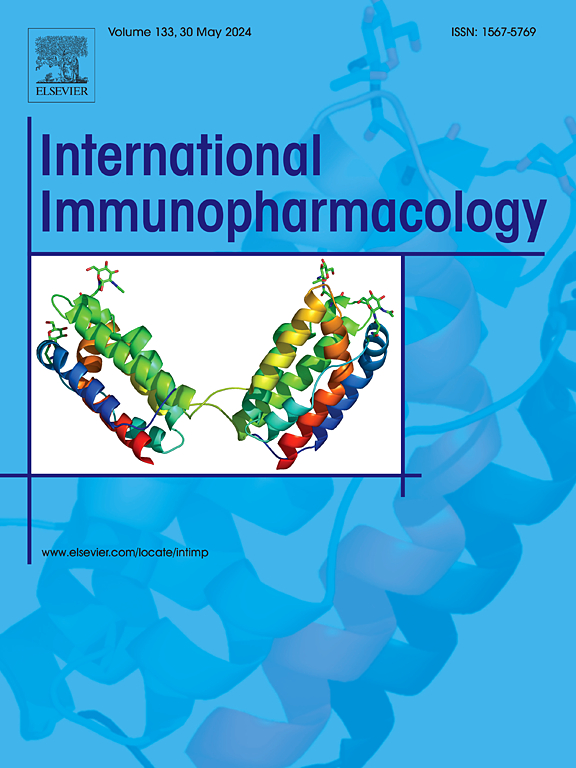RNF207通过KCNQ1介导的ERK/MEK信号通路激活促进骨肉瘤的增殖、迁移和侵袭
IF 4.7
2区 医学
Q2 IMMUNOLOGY
引用次数: 0
摘要
驱动指蛋白207 (RNF207)是一种E3泛素连接酶,通过泛素化和非蛋白水解机制调节靶蛋白的稳定性和活性。然而,其在骨肉瘤发病机制中的作用及其与患者预后的关系仍然知之甚少。方法将骨肉瘤细胞系和临床组织样本的生物信息学分析与检测验证相结合,评估RNF207的表达及其预后意义。通过功能分析来评估RNF207敲低或过表达对骨肉瘤细胞增殖、迁移和侵袭的影响。通过转录组分析、质谱分析和共免疫沉淀分析研究了机制见解。最后,采用皮下异种移植模型验证RNF207在体内骨肉瘤进展中的作用。结果rnf207在骨肉瘤细胞和临床标本中显著上调,并与不良临床结果相关。RNF207基因沉默抑制骨肉瘤细胞的增殖、迁移和侵袭,而其过表达则增强了这些恶性表型。此外,RNF207敲除可以减轻皮下异种移植模型中的肿瘤生长。在机制上,RNF207促进了泛素介导的KCNQ1降解,从而增强了MAPK信号通路的激活。结论在临床上,RNF207在骨肉瘤患者中的表达升高可作为疾病侵袭性和不良预后的生物标志物。在功能上,RNF207通过泛素化和降解KCNQ1来过度激活MAPK信号,从而在体外和体内驱动骨肉瘤的进展。这些发现表明RNF207是骨肉瘤的一种新的治疗靶点和预后标志物。本文章由计算机程序翻译,如有差异,请以英文原文为准。
RNF207 promotes the proliferation, migration and invasion of osteosarcoma through KCNQ1 mediated activation of ERK/MEK signaling pathway
Background
Ring finger protein 207 (RNF207) is an E3 ubiquitin ligase that regulates the stability and activity of target proteins via ubiquitination and non-proteolytic mechanisms. However, its role in osteosarcoma pathogenesis and association with patient prognosis remain poorly understood.
Methods
We integrated bioinformatics analyses of public databases with assayal validation in osteosarcoma cell lines and clinical tissue samples to assess RNF207 expression and its prognostic significance. Functional assays were performed to evaluate the impact of RNF207 knockdown or overexpression on osteosarcoma cell proliferation, migration, and invasion. Mechanistic insights were investigated through transcriptomic profiling, mass spectrometry, and co-immunoprecipitation assays. Finally, subcutaneous xenograft models were employed to validate RNF207's role in osteosarcoma progression in vivo.
Results
RNF207 was significantly upregulated in osteosarcoma cells and clinical specimens and correlated with adverse clinical outcomes. Genetic silencing of RNF207 suppressed osteosarcoma cell proliferation, migration, and invasion, whereas its overexpression enhanced these malignant phenotypes. Furthermore, RNF207 knockdown attenuated tumor growth in subcutaneous xenograft models. Mechanistically, RNF207 facilitated ubiquitin-mediated degradation of KCNQ1, thereby potentiating MAPK signaling pathway activation.
Conclusion
Clinically, elevated RNF207 expression in osteosarcoma patients serves as a biomarker for aggressive disease and unfavorable prognosis. Functionally, RNF207 drives osteosarcoma progression in vitro and in vivo by ubiquitinating and degrading KCNQ1 to hyperactivate MAPK signaling. These findings identify RNF207 as a novel therapeutic target and prognostic marker for osteosarcoma.
求助全文
通过发布文献求助,成功后即可免费获取论文全文。
去求助
来源期刊
CiteScore
8.40
自引率
3.60%
发文量
935
审稿时长
53 days
期刊介绍:
International Immunopharmacology is the primary vehicle for the publication of original research papers pertinent to the overlapping areas of immunology, pharmacology, cytokine biology, immunotherapy, immunopathology and immunotoxicology. Review articles that encompass these subjects are also welcome.
The subject material appropriate for submission includes:
• Clinical studies employing immunotherapy of any type including the use of: bacterial and chemical agents; thymic hormones, interferon, lymphokines, etc., in transplantation and diseases such as cancer, immunodeficiency, chronic infection and allergic, inflammatory or autoimmune disorders.
• Studies on the mechanisms of action of these agents for specific parameters of immune competence as well as the overall clinical state.
• Pre-clinical animal studies and in vitro studies on mechanisms of action with immunopotentiators, immunomodulators, immunoadjuvants and other pharmacological agents active on cells participating in immune or allergic responses.
• Pharmacological compounds, microbial products and toxicological agents that affect the lymphoid system, and their mechanisms of action.
• Agents that activate genes or modify transcription and translation within the immune response.
• Substances activated, generated, or released through immunologic or related pathways that are pharmacologically active.
• Production, function and regulation of cytokines and their receptors.
• Classical pharmacological studies on the effects of chemokines and bioactive factors released during immunological reactions.

 求助内容:
求助内容: 应助结果提醒方式:
应助结果提醒方式:


